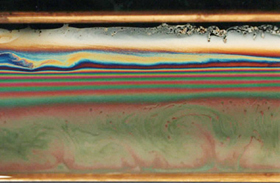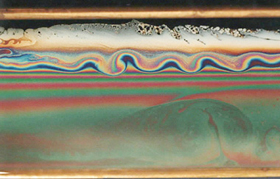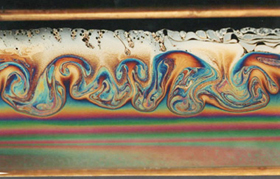
January 2004 (Volume 13, Number 1)
New Techniques for Controlling Fluid Flow Highlight the APS 2003 DFD Meeting
   Images of evaporatively-driven convection in a draining soap film. |
New techniques for predicting turbulent fluid flow, and modeling the transport of atmospheric contaminants were among the technical highlights presented during the 2003 meeting of the APS Division of Fluid Dynamics (DFD), held 23-25 November in East Rutherford, New Jersey. The meeting was jointly hosted by Syracuse University, Stevens Institute of Technology, Rensselaer Polytechnic Institute, Polytechnic University, and the City College of New York.
The scientific program featured lectures on nonlinear dynamics of fluid motion, and on "visiometrics," linking laboratory and computer simulated images to such artistic modes of expression as painting, photography, sculpture and digital animations. There were also eight invited lectures on such topics as non-diffusive gaseous ignition, aerosol dynamics, and the extreme fluid dynamics of white dwarfs and neutron stars. In addition, the meeting featured the 21st annual Gallery of Fluid Motion, showcasing images and graphics from computational and experimental studies of flow phenomena. The winning entries will be published in the September 2004 issue of the Physics of Fluids.
Lessons Learned From Red Cells. Despite a difference in size of about 15 orders of magnitude, there is a remarkable dynamical similarity between a red cell gliding on the endothelial surface matrix (the glycocalyx) that lines human capillaries and a person skiing on fresh snow powder. That's the conclusion of Sheldon Weinbaum and his colleagues at the City College of New York, who are drawing on that observation to develop a new concept for high speed trains whose track mimics the properties of the endothelial surface layer. In both the red cell and the skiers, according to Weinbaum, one can generate lift forces three to four orders of magnitude greater than ordinary lubrication theory, but the red cell is a far more efficient skier since it does not dissipate its excess pressure at its lateral edges.
LES Is More. Large eddy simulation (LES) is a promising technique for the prediction of turbulent fluid flows, in which the largest scales of turbulence are solved directly while the effects of the discarded small scales are modeled. However, some vital flow situations, such as turbulence near walls, cannot be simulated reliably using LES. Robert Moser of the University of Illinois described a new approach to LES modeling, incorporating stochastic estimation techniques—specifically, direct numerical simulation (DNS)—to optimize the LES model.
Improving Liquid Transfer Processes. Gravure coating and printing are common processes for producing micron scale coatings and patterns in a continuous manner, and may be well suited for the large scale fabrication of nano and microdevices on flexible substrates. It is crucial to understand the fundamental principles that govern the liquid transfer process in order to have precise control over the thickness of coatings and printed features, and to avoid defects due to incomplete liquid transfer. A team of scientists at the University of Minnesota have mimicked the process using a glass top with a curved surface that is passed over scaled-up gravure grooves and cells, and performed flow visualization studies.
Piezoelectric Printing. Piezoelectric printing of gold nanoparticle suspensions offers a promising solution for the production of fine line conductors in low cost, large area electronics, such as radio frequency ID tags and display drivers, according to a collaboration of scientists from the University of Illinois, Chicago, and Motorola. To create such conductors, a liquid suspension containing homogeneously dispersed nanosized spherical gold particles is printed using a single orifice, piezoelectric printhead to create continuous beads on flat target surfaces. The printed structures are subsequently processed thermally to yield conductive thin film gold patterns.
Bacterial Carpets for Microfluidics. Scientists from Brown University presented experimental results showing the use of bacterial carpets to achieve enhanced mixing and pumping in microfluidic channels. Bacterial carpets are formed by flowing a high concentration of bacteria into a microfluidic network. The cells stick to the surface while most of their flagella remain free to rotate in the fluid. The team observed significant enhancing of diffusion due to the carpet flagella motion, as well as the functioning of the bacterial carpet as an effective microfluidic pump.
Tracking Atmospheric Contaminants. Paritosh Mokhasi and Dietmar Rempfer of Illinois Institute of Technology are interested in modeling the transport of contaminants in the atmospheric boundary layer. A primary goal is to predict contaminant dispersion based on flow and concentration measurements using a minimum number of sensors. This precludes a direct approach, because atmospheric flows are almost always turbulent. They believe the Proper Orthogonal Decomposition (POD) method is a promising alternative because it allows them to describe a turbulent flow using a minimum amount of information, by decomposing the flow field into temporal coefficients and spatial functions. This enables them to reconstruct the entire 3D flow field exactly. Based on this method, they believe it will be possible to develop a practical approach to estimating the 3D turbulent flow field using velocity information from a small number of sensors.
Designing Winglets for MAVs. Since the mid 1990s, there has been growing interest in developing so called Micro Aerial Vehicles (MAVs) for both military and civilian uses. A team of scientists at the Arizona State University is performing a computational study of the effect of winglets on MAV performance, most notably in reducing drag. They found that the increase in lift obtained through the addition of winglets is more important for the enabling of low speed flight, and that winglets can lead to an increase in lift that is sufficiently large to improve the lift-to-drag ratio.
©1995 - 2024, AMERICAN PHYSICAL SOCIETY
APS encourages the redistribution of the materials included in this newspaper provided that attribution to the source is noted and the materials are not truncated or changed.
Associate Editor: Jennifer Ouellette
